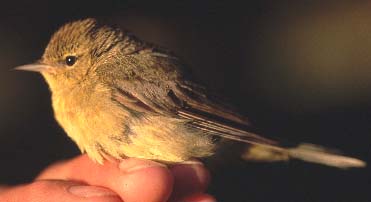 Right: Juvenile Orange-crowned
Right: Juvenile Orange-crownedOrange-crowned Warbler Adult, Juvenile, and First Prebasic Molt, Photos Susan Riddle
Below: Adult Male Orange-crowned Warbler
 Right: Juvenile Orange-crowned
Right: Juvenile Orange-crowned
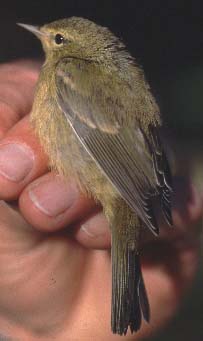
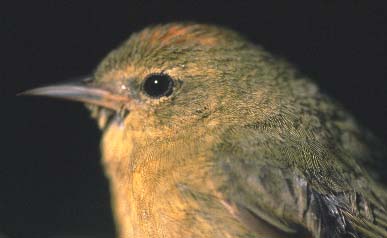
Left: Adult Male Orange-crowned Warbler
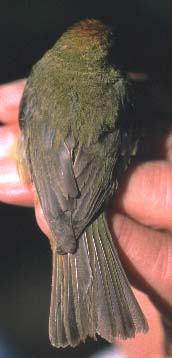 Left: Back view, adult male Orange-crowned Warbler
Left: Back view, adult male Orange-crowned Warbler
Below: Juvenile Orange-crowned Warbler exhibiting first pre-basic molt. Note the greater coverts (gr covs) feathers molting, not the primary coverts (pp covs).
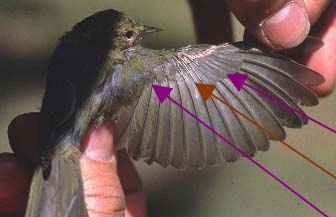
pp covs
gr cov molt area
gr covs
The following text is based on Identification Guide to North American Birds by Peter Pyle. The original text is paraphrased to fit the subject of this page.
In North America (north temperate zone) the majority of birds have a "predominant" replacement of feathers during the year. For most birds this occurs just after the breeding season (even for juveniles or adults that don't breed) and is referred to as the prebasic molt. In the example picture above one can see the ratty appearance of the feathers on the body of the juvenile bird. This juvenile bird is molting and it is in its juvenile plumage. When the prebasic molt occurs in a juvenile it is referred to as the first prebasic molt. (That is what is pictured above). In addition, a specific area on the wing can be seen to be molting.This area is termed the greater coverts. It is possible to have a partial first prebasic molt. The juvenile bird doesn't necessarily replace all of its feathers. During this process none, some, or all of the wing covertsmay molt. What is pictured above is an example of the process of covert molting where a small section has molted, and perhaps will continue later to another section, or perhaps not. If molting of the coverts continues it will be to the primary coverts. Covert molting starts at the lesser coverts (closer to the body of the bird and on top of the greater coverts and hard to pick out in the juvenile bird above because of the molt process itself) moves to the greater coverts, and finally ends at the primary coverts.